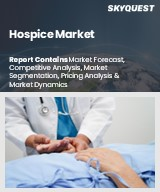
세계의 호스피스 시장 규모는 2023년에 753억 달러, 2024년 823억 8,000만 달러에서 2032년에는 1,690억 2,000만 달러로 성장하고, 예측 기간(2025-2032년) CAGR은 9.4%를 보일 전망입니다.
세계 호스피스 시장은 특히 북미, 유럽, 아시아태평양의 고령화와 함께 암, 알츠하이머병, 만성 심부전 등 말기 질환의 유병률 증가를 배경으로 큰 성장이 예상되고 있습니다. 호스피스 및 완화의료 서비스에 대한 자금 지원 및 상환 증가 등 정부의 이니셔티브는 시장 확대를 더욱 촉진하고 있습니다. 예를 들어, 미국 메디케어 및 메디케이드 서비스 센터(Centers for Medicare &Medicaid Services)는 최근 가치 기반 보험 모델을 확장하여 원격 호스피스 및 재택 치료를 대상으로 추가했습니다. 이를 통해 서비스 접근성을 높이고 입원 횟수를 줄이는 데 도움을 주고 있습니다. 원격 호스피스와 같은 혁신은 원격 의료를 통해 원격으로 돌보는 돌봄을 촉진하고 환자가 안전한 화상 회의를 통해 의료 전문가와 상담할 수 있도록 합니다. 이 기술은 의료 서비스가 부족한 지역에 필수적이며, 신속한 증상 추적과 입원을 예방하기 위한 개입을 제공합니다.
Global Hospice Market size was valued at USD 75.3 billion in 2023 and is poised to grow from USD 82.38 billion in 2024 to USD 169.02 billion by 2032, growing at a CAGR of 9.4% during the forecast period (2025-2032).
The global hospice market is poised for significant growth, driven by the rising prevalence of terminal illnesses such as cancer, Alzheimer's, and chronic heart failure, alongside an aging population particularly in North America, Europe, and parts of Asia-Pacific. Government initiatives, including increased funding and reimbursement for hospice and palliative care services, further propel market expansion. For example, the U.S. Centers for Medicare & Medicaid Services recently expanded its value-based insurance model to include telehospice and home care, enhancing service access and reducing hospital admissions. Innovations like telehospice facilitate remote compassionate care through telehealth, allowing patients to consult with healthcare professionals via safe video conferencing. This technology is vital for underserved areas, providing prompt symptom tracking and interventions to prevent hospitalizations.
Top-down and bottom-up approaches were used to estimate and validate the size of the Global Hospice market and to estimate the size of various other dependent submarkets. The research methodology used to estimate the market size includes the following details: The key players in the market were identified through secondary research, and their market shares in the respective regions were determined through primary and secondary research. This entire procedure includes the study of the annual and financial reports of the top market players and extensive interviews for key insights from industry leaders such as CEOs, VPs, directors, and marketing executives. All percentage shares split, and breakdowns were determined using secondary sources and verified through Primary sources. All possible parameters that affect the markets covered in this research study have been accounted for, viewed in extensive detail, verified through primary research, and analyzed to get the final quantitative and qualitative data.
Global Hospice Market Segments Analysis
Global Hospice Market is segmented by Services, Care Type, Application and region. Based on Services, the market is segmented into Nursing Services, Medical Supply Services, Counseling Services, Short Term Inpatient Services, Physician Services and Others. Based on Care Type, the market is segmented into Acute Care and Respite Care. Based on Application, the market is segmented into Home Settings, Hospitals, Specialty Nursing Homes and Hospice Care Centres. Based on region, the market is segmented into North America, Europe, Asia Pacific, Latin America and Middle East & Africa.
Driver of the Global Hospice Market
The global hospice market is undergoing significant transformation, driven by swift technological advancements that are revolutionizing the delivery of end-of-life care. Innovations such as tele-hospice services, electronic health records (EHRs), and remote patient monitoring are enhancing the quality of care and access for patients. These technologies enable seamless coordination among various healthcare providers and facilitate personalized, immediate support for patients receiving care in their homes. As a result, the hospice industry is not only improving efficiencies but also elevating the overall patient experience during what is often a challenging time, ultimately shaping the future of end-of-life care services.
Restraints in the Global Hospice Market
One of the most significant challenges facing the Global Hospice market is the substantial investment needed to establish and maintain high-quality hospice care services. This issue affects both independent hospice providers and those integrated within health systems, as the initial costs for essential infrastructure, medical equipment, skilled personnel, training, and technology implementation can strain the resources of any hospice organization. While digital and telehealth solutions present valuable advancements in care delivery, they necessitate considerable upfront investments in hardware and platforms, which limits their accessibility in underserved regions with fewer resources. This financial barrier poses a significant restraint on the market's growth.
Market Trends of the Global Hospice Market
The global hospice market is witnessing a significant trend toward home-based and community-centered care, driven by patient preferences for receiving end-of-life services in familiar surroundings. This shift is facilitated by advancements in telehealth and remote monitoring technologies, enabling healthcare providers to deliver comprehensive care plans alongside continuous support outside traditional clinical settings. As patients increasingly opt for hospice services at home, providers are enhancing their approaches to improve overall patient satisfaction and reduce hospital admissions, thereby showcasing the effectiveness of home-based models. This evolving landscape reflects a growing recognition of the importance of personalized, patient-centered care in the hospice sector.